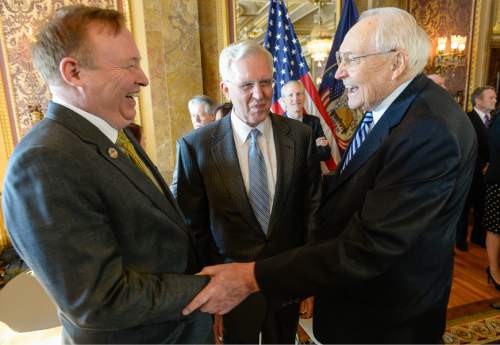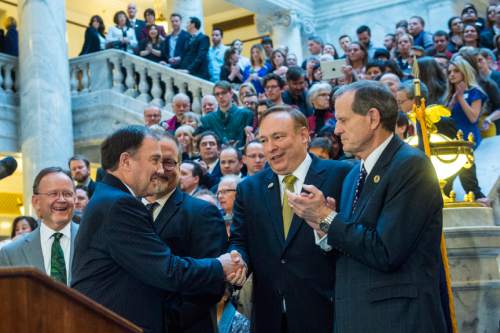This is an archived article that was published on sltrib.com in 2015, and information in the article may be outdated. It is provided only for personal research purposes and may not be reprinted.
Nearly two decades ago when Jim Dabakis was the first board chairman for Utah's new gay pride center, he sat down and penned a letter to Mormon church leaders asking for an opportunity to meet.
"I got back a letter that said, we really don't have anything to talk about," said Dabakis, now a Democratic lawmaker for Salt Lake City and the only openly gay member of the Utah Senate.
About six years later, following the launch of the gay rights advocacy group Equality Utah, Dabakis said he made a second plea to The Church of Jesus Christ of Latter-day Saints. Again, he was, politely, shot down.
Fast forward to 2015 and a landscape dramatically changed: Dabakis and two senior church leaders stand together at a rare — some say historic — Capitol Hill press conference to unveil bipartisan legislation to bar discrimination against lesbian, gay, bisexual and transgender Utahns, while safeguarding religious freedoms for churches and other religious groups.
SB296, which has already been signed into law by Gov. Gary Herbert, is being hailed by many as landmark legislation not just for its model approach to balancing gay rights and religious freedom, but as the only time a Republican-controlled legislative process has resulted in expanded protections for LGBT persons.
"This is a tremendous moment for Utah cultural history," Dabakis said last week, hours after the bill vaulted over its final legislative hurdle with wide support from the Utah House. "This is a night people will, I think, revere for many years."
In many ways, it's a cultural threshold that Utah seemed unlikely to pass, even as the gay and transgender rights movement makes rapid and broad advances nationwide.
The divide between LGBT rights and the Mormon church has often been bitter. Church theology holds at its center a focus on traditional marriage. For decades church leaders have denounced homosexuality and at times have excommunicated gay members or endorsed reparative therapies and prayer as mechanisms for altering sexuality.
As early as the 1990s, the church also put its considerable heft behind efforts to ban gay marriage across the country, including in 2008 mobilizing tens of thousands of its members to donate time and money to help pass Proposition 8, the California ballot initiative that barred same-sex unions in that state.
In Utah, which had banned gay marriage both in statute and through a constitutional amendment, LGBT advocates and their allies began working to ensure rights for the gay and transgender community more than a decade ago, first by expanding the protections in Utah's hate crimes law. That legislation took nearly a decade to pass, even after it got lukewarm support — more accurately a statement of non-opposition — from the LDS Church and throughout was accompanied by hurtful, public rhetoric from many conservative lawmakers about the sins and perversion of homosexuality.
"The entire time I was on Capitol Hill, there were always anti-gay bills," said Jackie Biskupski, the first lesbian ever elected to the Utah House, adding that some in the body would not sit next to her or make eye contact. "There were always people who just didn't want you to have what they had."
After hate crimes, proposals for statewide nondiscrimination protections were introduced but, until now, failed to advance in 6 of 7 attempts, including in 2014, when lawmakers punted the issue down field as they waited to see if the U.S. Supreme Court would overturn a Utah federal judge's December 2013 ruling declaring the state's ban on same-sex unions was unconstitutional.
Dabakis contends that the marriage debate, and specifically Proposition 8, was a blessing in disguise. Blowback on the Mormon church, including a massive march days after Prop. 8 passed in November 2008 around Temple Square by thousands of LGBT activists, created space for unprecedented dialogue.
In 2009, five representatives from Utah's LGBT community, including Dabakis, and four church officials began a series of quiet, sometimes uncomfortable meetings.
"There was a lot of fear and misunderstanding and apprehension on both sides," Dabakis said. "That very first meeting was awkward."
Both sides found out they had plenty to learn about each other, and both sides have come a long way in their mutual understanding, he said.
"It's important out that this has not really been a theological evolution," Dabakis said. "This has been a social dialogue."
It's not clear why church leaders chose 2015 to step into the nondiscrimination spotlight and beyond calls for fairness, none of their public statements have hinted at their reasoning. However, in an interview with Salt Lake City's KUTV, which aired Saturday, Elder D. Todd Christofferson of the Quorum of the Twelves Apostles said the timing seemed right.
Previous attempts to legislate either nondiscrimination or religious liberties lacked the balance church leaders believed important, he said. SB296, which grew out of weeks of negotiations between lawmakers, LGBT leaders and church officials, provides a mechanism for protecting the LGBT community "in a way that was not threatening to other things that we hold precious," he said.
"This is not a doctrinal evolution or a doctrinal change as far as the church is concerned," Christofferson told KUTV. "It's how things are approached, how things can come together when the time is right … how to be sensitive as you grow in understanding, for example, about same-sex attraction as we all have."
Mormon historians, scholars and other church-watchers believe the faith's involvement in encouraging passage of nondiscrimination and religious liberty law reflects a collection of internal and external realities.
The church has softened its stance on homosexuality to differentiate between feelings and action and said that the origins of sexuality, once thought to be fixed, are not fully understood. The church has spoken out against gay bullying and launched a website aimed a helping gay members and lay church leaders better address the collision between sexuality and faith.
More pragmatically, the shift reflects an acknowledgment that the battle over same sex marriage is likely lost and that involvement in Prop. 8 disenfranchised large numbers of church member, Mormon historian Greg Prince said. The faith's leaders are also heeding the voices of the many Mormon families who are telling them from the pews that they are no longer willing to reject their gay children, he said.
"Those factors, in my mind are all in the mix," said Prince, who is researching a book on the church's historical role in gay politics. "This is a cultural change that's going on in the church, it's not just a matter of policy."
Utah State University professor Philip Barlow, an expert in Mormon history and culture, calls the church's position on nondiscrimination law "a huge step," but isn't entirely surprised by the shift.
"The world turns and Mormons have their commitments. But they have to be navigated through historical change. They always have been since the church's founding," Barlow said. "What is transient and what is permanent in the gospel at any time? It's always a mixture, even though when people talk about the gospel and quote scripture they think they have a handle on the eternal."
Biskupski views the church's actions this year as an olive branch to the LGBT community that will have a wider impact across Utah and result in more acts of inclusion and acceptance as well as opportunities to draw in other disenfranchised pockets of society, like religious and racial minorities.
"This is a great step forward. It's extremely meaningful that so many layers of power and authority in our community came together on this," she said. "It gives us a great launching pad to do more."





